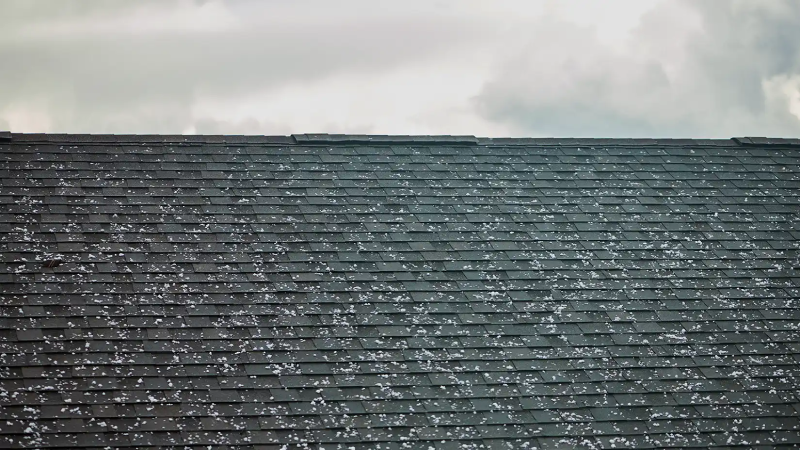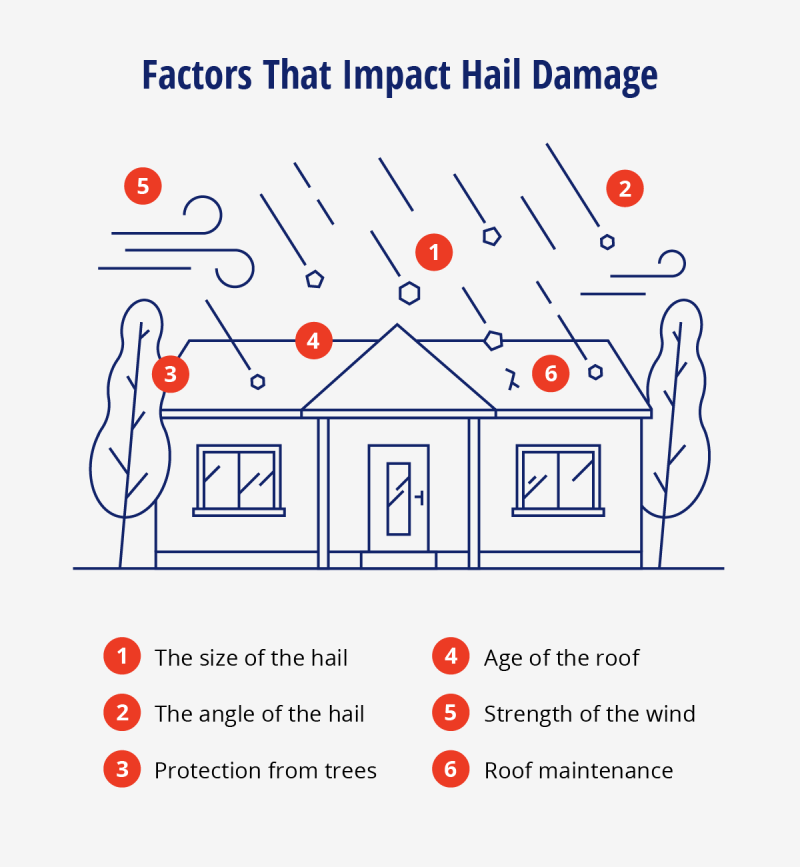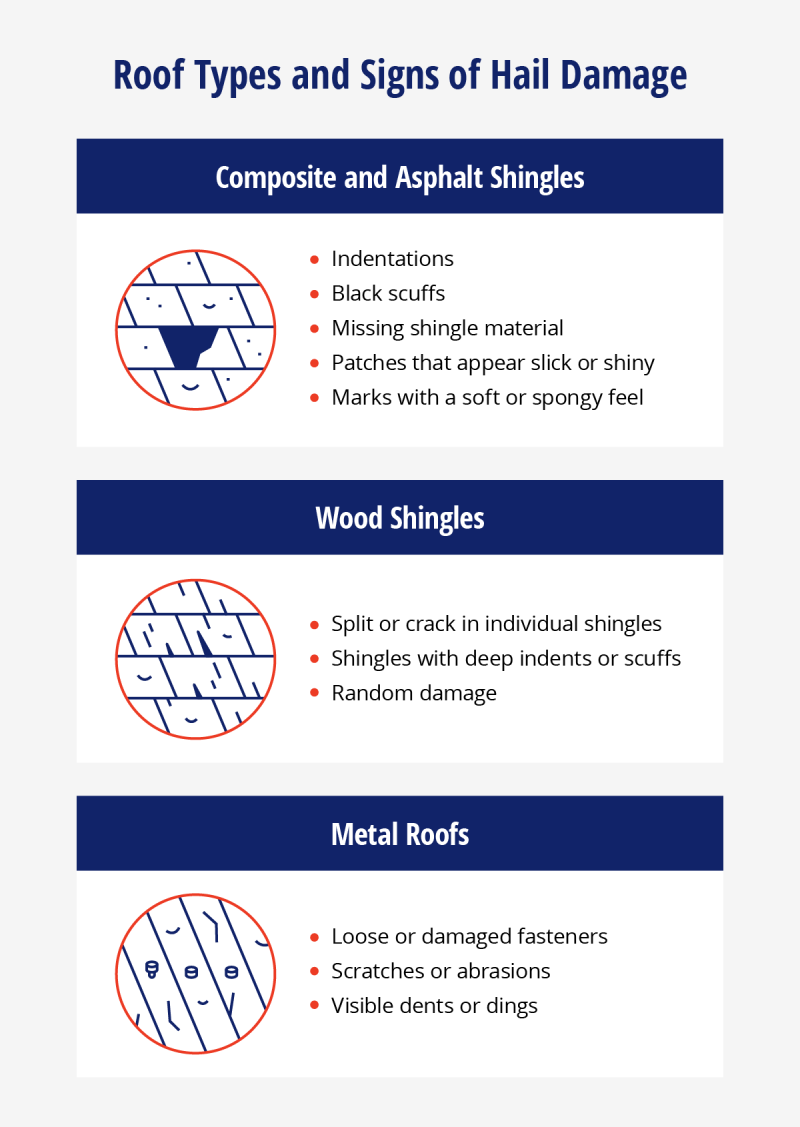
Rainbow Restoration explains the importance of identifying and addressing hail damage to your roof promptly.
|
Originally Published March 4, 2022
Hail damage typically looks like missing or cracked shingles, bald spots with missing granules, and dents or dings, but can differ depending on the type of roof.
Hail can be dangerous and cause substantial damage to vehicles, homes, and businesses. Hail damage leaves a property susceptible to water damage, which compounds destruction.
While hail damage can seem obvious after a severe hail storm, it can also be more subtle and look different based on the roof material.
Learn how to spot roof hail damage and why mitigation should be expedited to avoid further water damage.
Table of Contents:
Signs of Damage on Composite and Asphalt Shingles
Composite and asphalt shingles are relatively durable, but can still be susceptible to hail damage. Look for specific signs of wear and tear and address any problems as soon as possible to prevent costly repairs down the road.
Key indicators of damage on composite and asphalt shingles include:
- Indentations: Look for dimples or depressions in the shingle surface. They can be round or irregular and may vary in size, depending on the hailstone or debris that caused them.
- Black scuffs: These will appear as dark, streaky marks on the shingle surface. They can be thin and wispy or appear in broader patches.
- Missing shingle material: Shingles might be curled upward at the edges or have chunks missing entirely. In severe cases, the underlying black felt material (underlayment) might be exposed.
- Patches that appear slick or shiny: Asphalt shingles that have lost their usual rough texture will look bald. Damaged asphalt shingles will have a smooth, glossy surface and almost look like they’re wet.
- Marks with a soft or spongy feel: Damaged areas might feel noticeably softer or even give slightly under pressure compared to the firmer texture of undamaged shingles.
Signs of Damage on Wood Rooftop Shingles
While wood shingles add a rustic charm to a property, they also require more maintenance and attention to help uphold their integrity. Unlike composite or asphalt shingles which are more hail-resistant, wood shingles are particularly vulnerable to hail.
Warning signs of damage on wood roof shingles include:
- Split or crack in individual shingles: Look for breaks or fissures running along the wood grain. Deep cracks can expose the underlayment and compromise the roof's waterproofing.
- Shingles with deep indents or scuffs: Examine the shingle surface for significant gouges or scrapes that penetrate beyond the surface layer. These can be caused by hail, as well as falling branches or improper foot traffic.
- Random damage: Unlike composite or asphalt shingles that deteriorate uniformly, wood shingles can show isolated patches of damage, often more visible on one side of the roof than the other. Look for areas with a higher concentration of cracked, dented, or missing shingles, as it could indicate underlying problems, such as uneven exposure, water damage, or even damage caused by animals.
Signs of Damage on Metal Roofs
Hailstone damage on a metal roof often appears as a dent (like on a car hood or truck rooftop). In rare events, hail can puncture a metal roof.
Signs of damage on a metal roof include:
- Loose or damaged fasteners: Metal roof panels are secured with specialized fasteners. Look for fasteners that are loose, popped out, or show signs of rust. Damaged fasteners can compromise the panel's stability and allow water infiltration underneath.
- Scratches or abrasions: Metal surfaces are susceptible to scratches and abrasions from hail, windblown debris, or improper cleaning methods. While minor scratches might be purely cosmetic, deeper gouges can expose the underlying metal to rust and potentially weaken the panel.
- Visible dents or dings: Hail is a major culprit for dents and dings in metal roofs. The severity of the damage will depend on the hailstone’s size and the thickness of the metal panels. Shallow dents might be a cosmetic concern, but larger or deeper dents can compromise the panel's integrity and lead to roof leaks and further damage.

What Size Hail Will Damage a Roof?
Hail in excess of 1 inch in diameter is most likely to cause damage to an average roof. A roof in disrepair may be damaged by smaller hail. Other factors play a role in how much hail damage a home or business sustains, such as the angle of the hail, protection from fallen trees, and the roof age.
On average, hail falls between 9 and 25 miles per hour. The largest hailstones can reach up to 90 miles per hour, and it’s worth noting that tornado wind speeds can reach over 200 miles per hour. The strength of the wind plays a role in how much damage hail does to a roof by potentially propelling it faster than terminal velocity, giving it more strike force.
How To Tell if a Roof Has Hail Damage
Remember, not every hailstorm causes roof damage. Shingles and roofing materials often absorb hail without issue.
Nonetheless, roofs should be professionally inspected after hail storms as a precautionary measure. If hail damage has compromised the integrity of a roof, water can seep through and cause water damage and secondary damage including mold growth. Left unaddressed, these leaks can cause structural problems to the roof and ceiling.
Call a Professional
Professional roofers will examine the roof for signs of storm damage, including missing shingles, dents, and loose flashing. If there’s water damage, the professionals at Rainbow Restoration® can help. For records and insurance purposes, they will take photos of any damage they find. This documentation can be crucial when filing a claim.
Most importantly, if they discover any issues that require immediate attention, they'll be able to provide temporary solutions like board-up and tarp-over services to prevent further water infiltration until repairs can be made. This ensures the roof remains protected while navigating the claims process.
Does Insurance Cover Hail Damage?
Some insurance policies cover hail damage, but not all. Contact the insurance agency directly to learn if the policy includes specific coverage for hail. If hail damage is suspected, the insurance provider may send a representative to inspect the damage or ask for photos.

Trust Rainbow Restoration for Emergency Disaster Restoration Services
Roof hail damage and subsequent water damage should always be addressed promptly and managed by experienced professionals. Rainbow Restoration offers board-up, tarp-over, and water damage restoration services to ensure the property is safe and dry.
Call Rainbow Restoration for 24/7 emergency repair services.
This article is intended for general informational purposes only and may not be applicable to every situation. You are responsible for determining the proper course of action for your property. Services should be performed by licensed and experienced professionals. Rainbow Restoration is not responsible for any damages that occur as a result of this blog content or your actions. For the most accurate guidance, contact a Rainbow Restoration professional for a custom, on-site assessment.
Roof Hail Damage FAQ
Can Hail Damage a Metal Roof?
Yes, large hailstones or severe storms can leave dents, which are primarily cosmetic concerns. In rare cases, hail may puncture the metal, leading to leaks. It's always wise to have a professional assess any hail impact on a metal roof for a complete picture.
What Does Hail Damage Do to Shingles?
The most common hail damage to shingles is the loss of granules, the small pebbles that give shingles texture and protect the asphalt underneath from sun damage. Hail can also cause cracks or even holes in the shingles themselves, leaving the roof vulnerable to leaks. In some cases, the impact might even bruise the shingle, weakening it and making it more prone to future damage.
Why Should You Repair Hail Damage?
Unfixed hail damage exposes the roof to the elements, increasing the risk of leaks, which can lead to expensive interior water damage, mold growth, and structural problems. Promptly addressing hail damage ensures the roof’s integrity, potentially avoiding a full roof replacement down the line.
How Can a Person Tell if a Roof Is Damaged by Hail?
Look for broken or missing shingles, especially asphalt or composite ones. Check the gutters for an unusual amount of shingle granules. Dents in vents or flashing can also indicate hail damage.
What Does Hail Damage to Shingles Look Like?
Hail damage on shingles can show itself in a few ways: bald spots where protective granules have been knocked off, cracks or even holes in the shingle itself, and sometimes bruising that makes the shingle feel softer than usual.
Can Pea-Sized Hail Damage a Roof?
Small, pea-sized hail may not leave a mark, but repeated exposure to even small hailstones over time could contribute to wear and tear on older or already weak shingles. For complete peace of mind, it's always best to have a professional inspect the roof after any hailstorm.

